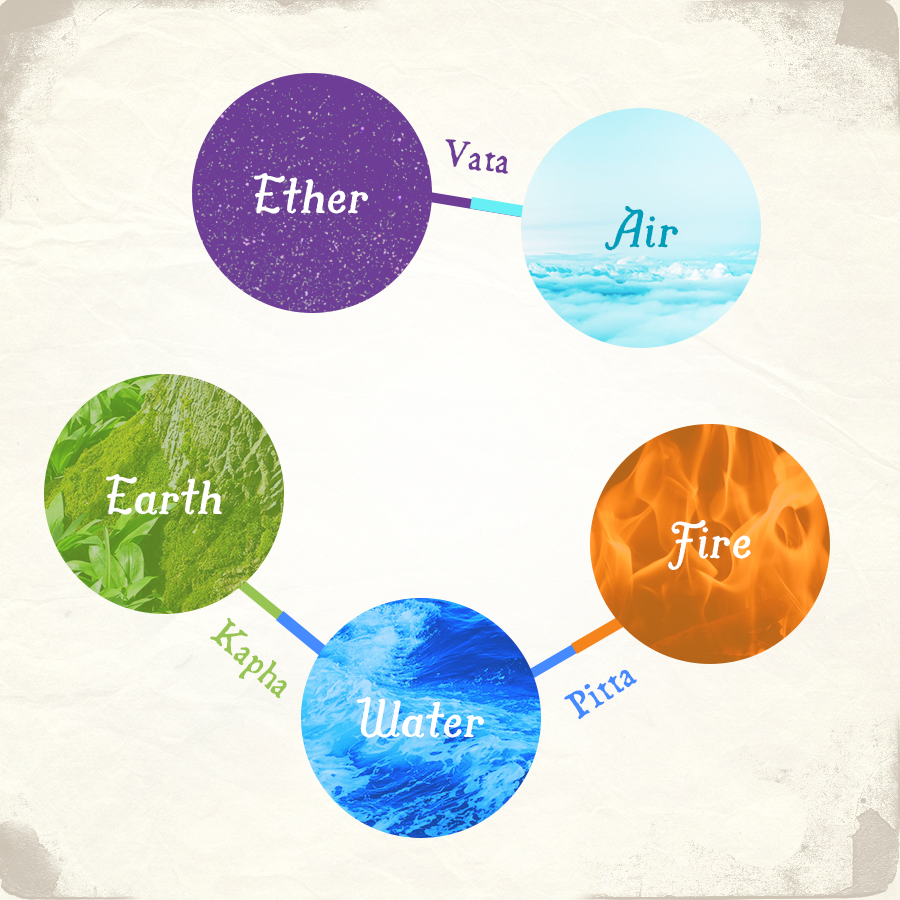“When diet is wrong, medicine is of no use. When diet is correct, medicine is of no need.”
Ayurveda is one of the world’s oldest holistic (“whole-body”) healing systems. Ayurveda means “The Science of Life.” derived from the Sanskrit words ayur (life) and veda (science or knowledge). Ayurvedic knowledge originated in India more than 5,000 years ago and is often called the “Mother of All Healing.”
Ayurveda focuses on whole-body healing and states that a person’s dosha, a type of bio-energy (bio-humor), determines their personality and health. Just as everyone has a unique fingerprint, each person has a particular pattern of energy—an individual combination of physical, mental and emotional characteristics—which comprises their own constitution. This constitution is determined at conception by a number of factors and remains the same throughout one’s life.
Knowledge of Ayurveda enables one to understand how to create balance of body, mind and consciousness according to one’s own individual body constitution and how to make lifestyle changes to bring about and maintain this balance.
Ayurveda is based on the idea that the world is made up of five elements (Panch Mahabhutas) —
- Aakash (space/Ether)
- Jal (water)
- Prithvi (earth)
- Agni (fire)
- Vayu (air)

The Three Doshas:
A combination of each of these elements results in three doshas. These doshas are believed to be responsible for a person’s physiological, mental, and emotional health.
- Vata (Air + Ether) governs movement of all things in the body. It is cold, light, flexible, fast-moving, erratic, and rough.
- Pitta (Fire + Water) governs metabolism and digestion. It is oily, sharp, hot, light, moving, liquid, and acidic.
- Kapha (Earth + water) governs structure and lubrication. It is moist, cold, heavy, dull, soft, sticky, and static.
A person’s unique ratio of vata, kapha, and pitta is said to define their Ayurvedic constitution, a blueprint to achieve optimal health.
We all are born with our unique balance of Doshas, which creates our constitution. This balance changes with the seasons, time of day, environment, and stage of life. The predominant dosha determines our physique, our mental and emotional tendencies and our predisposition to certain health problems.

Characteristics of Three Doshas
- Vata Dosha: Slender with prominent features, moody, impulsive, enthusiastic. This dosha is associated with the large intestine, pelvis, bones, ears, thighs, and skin.
- Pitta Dosha: Medium build, well-proportioned, stable weight. This dosha is associated with the small intestine, stomach, sweat glands, eyes, skin, and blood.
- Kapha Dosha: Solid, heavy, strong, with a tendency to be overweight. This dosha is associated with the lungs, chest, and spinal fluid.
Agni: The Digestive Fire:
Agni is a Sanskrit term meaning fire. It is responsible for important functions such as digestion, metabolism, transformation, strength and intelligence. Agni enables our bodies to utilize the 5 elements in food, extract them and transform them into bodily elements. When Agni is sufficient, it prevents the build up of toxins (Ama) in the body, the mind and senses are clear and we have energy to channel our lives in a positive direction. However, when deficient, it causes a build up of toxins in the body which gives rise to dullness, heaviness, stagnation and cloudiness of mind and perception.
Dhatus and Ojas:
There are seven Dhatus or tissues in the body that receive nourishment in a specific order when the food is digested with the help of Agni. Ojas is the opposite of ama (toxins) and is the most refined essence of the body.
- Rasa equates with plasma. It nourishes the cells.
- Rakta forms when blood cells generate.
- Mamsa results the transformation of blood into muscles.
- Medha is the fat tissue nourished by the muscles.
- Asthi results from the conversion of fat into bones.
- Majja forms when bone tissue nourishes the nerves.
- Shukhra is the reproductive fluid that contains the most refined ojas.
The 3 Gunas:
Guna is a Sanskrit word which means “quality, peculiarity, attribute, or tendency.” In Yoga and Ayurveda, a guna is a tattva or element of reality that can affect our psychological, emotional and energetic states. The gunas cannot be separated or removed in oneself but can be consciously acted upon to encourage their increase or decrease. A guna can be increased or decreased through the interaction and influence of external objects, lifestyle practices and thoughts. Like the doshas, all three exist in a combination within us. However, one dominates.
- Sattva: is a state of harmony, balance, joy, and intelligence. Promotes health and calmness. In order to increase Sattva, one must lead an Ayurvedic lifestyle as well as follow a satvik diet. Other sattvic qualities are delight, happiness, peace, wellness, freedom, love, compassion, equanimity, empathy, friendliness, focus, self-control, satisfaction, trust, fulfillment.
- Rajas: is a state of energy, action, change, and movement. Stimulates us and supports dynamic activities but brings restlessness and agitation in excess. Other rajasic qualities are anger, euphoria, anxiety, fear, irritation, worry, restlessness, stress, courage, rumination, determination, chaos.
- Tamas: is a state of darkness, inertia, inactivity, and materiality. Brings structure and preserves the body. But it creates delusion, ill will, drowsiness, apathy, and negative qualities in excess. Other tamasic qualities are laziness, disgust, attachment, depression, helplessness, doubt, guilt, shame, boredom, addiction, hurt, sadness, apathy, confusion, grief, dependency, ignorance.
Ayurvedic remedies and lifestyle aim to maintain balance between all of the elements described above. The focus is on living in accordance with one’s dosha and in tune with the nature.
Join my Facebook Group to learn more about Ayurvedic healing, Yogic lifestyle, and Mindfulness tips.
